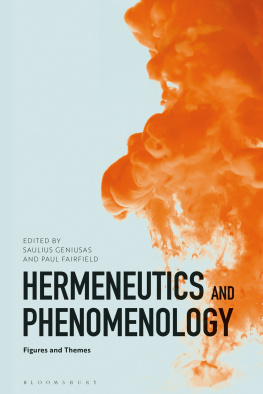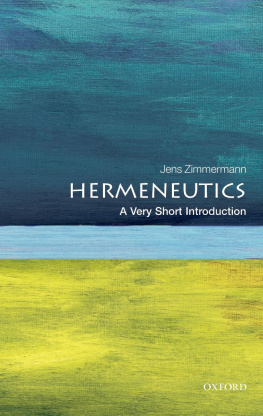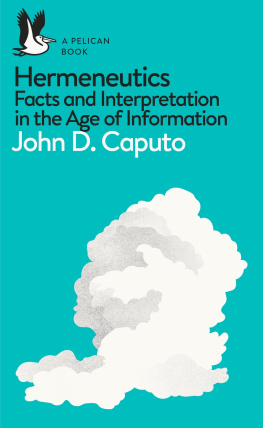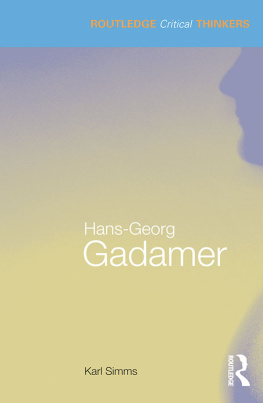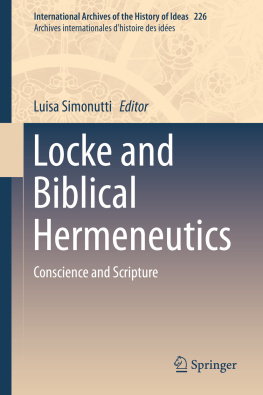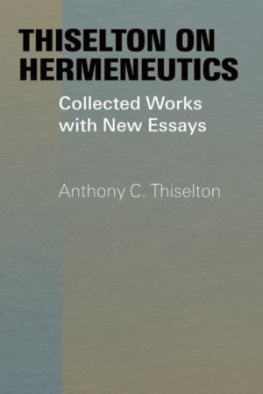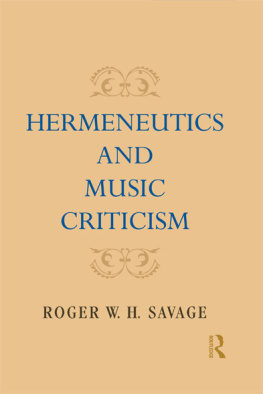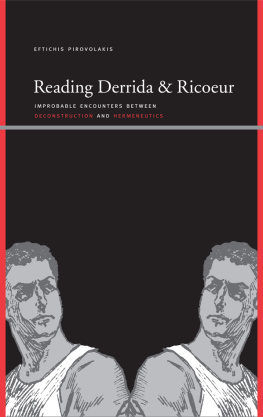Hermeneutics and Phenomenology
Also available from Bloomsbury
Relational Hermeneutics , edited by Paul Fairfield and Saulius Geniusas
Philosophical Hermeneutics Reinterpreted , Paul Fairfield
Gadamer and Ricoeur , edited by Francis J. Mootz III and George H. Taylor
The Ethics of Time , John Panteleimon Manoussakis
Hermeneutics between History and Philosophy , Hans-Georg Gadamer
For Geraldine and Gwyneth
Hermeneutics and Phenomenology
Figures and Themes
Saulius Geniusas and Paul Fairfield

Contents
Saulius Geniusas and Paul Fairfield
Hermeneutics and phenomenology can be spoken of in many ways. In what follows, they will be conceptualized as philosophical traditions that, along with a few others, form the contours of contemporary continental philosophy. The present book will address neither ancient, medieval, or non-Western hermeneutics (such as Vedic or Buddhist hermeneutics), nor will it engage in hermeneutics as it is understood outside of philosophy (such as literary or biblical hermeneutics). The same restrictions will apply to phenomenology: this book does not address the diverse ways in which the concept of phenomenology was either employed in the history of philosophy, appropriated in recent analytical philosophy, or amended in other disciplines where it is often used as a synonym for introspectionist methodology. Continental philosophy constitutes the general framework within which the present book brings hermeneutics and phenomenology into dialogue with each other.
Even when such conceptual restrictions are introduced, hermeneutics and phenomenology have too rich a history for the question of their relationship to be exhaustively addressed in a single book. It is inevitable that an anthology such as this one would focus on particular figures and themes while leaving others out of consideration. Our goal in what follows is to bring post-Husserlian hermeneutics, as represented especially by Martin Heidegger, Hans-Georg Gadamer, and Paul Ricoeur, into dialogue with classical phenomenology, as represented by Edmund Husserl, Max Scheler, and Maurice Merleau-Ponty.
While much of the landscape of twentieth-century continental philosophy is shaped by phenomenology and hermeneutics, the relation between them remains puzzling. In the second half of the twentieth century it was common to claim that what distinguishes hermeneutics from phenomenology is the latters idealism, and that once phenomenology liberates itself from this commitment it becomes hermeneutical phenomenology. Today many have become more sceptical of the hermeneutical turn in phenomenology thus conceived, at least in the sense that we have become more sensitive to what alternative paths such an absorption of phenomenology into hermeneutics closes off and what further problems it itself introduced. The hermeneutical turn was neither the first nor the last turn in phenomenology. It was preceded by the so-called existential turn (Karl Jaspers, Hannah Arendt, Gabriel Marcel, Jean-Paul Sartre, etc.) and followed by the so-called theological turn (Jean-Luc Marion, Michel Henry, Richard Kearney, etc.). Each of these turns proved to be deeply problematic. It must be stressed that no one to date has managed to eliminate the suspicion that these existential, hermeneutical, and theological phenomenologies are in fact not very phenomenological, despite the fact that they identify themselves as such. The central goal of this book is to address the numerous issues to which the relation between phenomenology and hermeneutics gives rise. Our goal is to demonstrate that this relation remains at once ambiguous and of central importance to the inner coherence and further development of continental philosophy.
Questions regarding the relation between hermeneutics and phenomenology are of central significance for contemporary philosophy in general and continental philosophy in particular. For better or worse, the hermeneutical turn in phenomenology has heavily influenced subsequent continental thought; indeed, in the absence of this turn the landscape of contemporary philosophy would have been profoundly different. How one conceives the relation will depend on what one understands to be the meaning of the relational terms as well as on where one is situated in either or both of these traditions. A multi-perspectival volume on hermeneutics and phenomenology one that illuminates how the relation is viewed from both hermeneutical and phenomenological standpoints is thus much needed. Only on the basis of such a re-evaluation can one further reassess the significance of both traditions for contemporary philosophy.
While phenomenology is largely associated in philosophy with the tradition stemming from Edmund Husserls investigations, Husserl was not the first to employ the concept. We come across phenomenology already in the eighteenth century: Johann Heinrich Lamberts philosophical discourse was explicitly defined with reference to the concept of a phenomenon. Among others, Hegel employed this concept as well, and his employment of it is by no means anachronistic. Indeed, the birth of classical phenomenology, associated with Husserls name, did not mark the death of Hegelian phenomenology. When Ernst Cassirer in the 1920s described his philosophy as a phenomenology of symbolic forms, he employed the concept of phenomenology in line with Hegel rather than Husserl. Similarly, when Japanese philosopher Miki Kiyoshi identified his work of the 1930s as phenomenological, he followed in Cassirers footsteps and had in mind the continuation of Hegelian thought. Husserl was neither the first nor the last thinker to employ the concept of phenomenology. As Paul Ricoeur has remarked, the history of phenomenology is a history of Husserlian heresies. Thus, phenomenology is understood differently depending on whether it is conceived in line with Husserls, Heideggers, Schelers, Merleau-Pontys, Ricoeurs, Marions, Henrys, or some other projects.
Hermeneutics as well is not spoken of in one way. For the most part, when hermeneutics comes into contact with phenomenology, it is the hermeneutics of the late nineteenth and (especially) twentieth centuries. In this context the hermeneutics of Dilthey, Heidegger, Gadamer, and Ricoeur are of foremost importance. Although most of the contributors to this book focus on Heideggerian and post-Heideggerian hermeneutics, pre-Husserlian hermeneutics particularly Diltheys contribution is also taken into consideration.
It is a common view that the issue of the relation between classical phenomenology and post-Husserlian hermeneutics was settled some fifty years ago. On this often uncritically accepted view, the future of phenomenology depends on its capacity to be integrated within hermeneutics. Presumably, classical phenomenology in general, or Husserlian phenomenology in particular, is a form of outdated and unsustainable idealism, and only insofar as it is liberated from this can it continue as a living philosophical tradition, with a voice that still resonates in the context of contemporary philosophical debates. Supposedly, the hermeneutical turn in phenomenology, especially as defended by Ricoeur (see his Hermeneutics and Phenomenology, which many chapters of this book will address), provided classical phenomenology with a second life. Yet is it really the case that phenomenology required a hermeneutical turn to be sustained? Kevin Hart, for one, contends in his contribution that before dismissing classical phenomenology for its alleged foundationalism, intuitionism, subjectivism, or transcendentalism, we need to inquire anew into the exact meaning of such concepts as absolute grounding, intuition, the reduction, and transcendental subjectivity. We consider it a strength of this book that it offers detailed analyses of these and other central concepts in phenomenology. The contributions that fall into Part II are meant to bring into question the hermeneutical critique of phenomenology. These chapters demonstrate that this critique is in some ways misplaced and that both classical phenomenology in general and Husserlian phenomenology in particular have a compelling answer to this critique.

